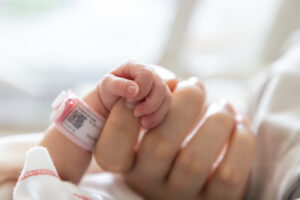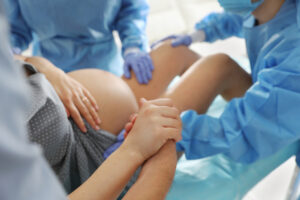
The experience of pregnancy and bringing a baby into the world is both exciting and intense. In most cases, although painful and perhaps scary, deliveries go well. However, unfortunately, labor and delivery mistakes happen every day, resulting in possible injuries to the newborn and the mother.
In some cases, an infant or mother’s injury is caused by an illness or lengthy labor. However, some are due to medical negligence by a healthcare provider failing to perform at the standard level of care.
Doctors and labor and delivery personnel should always anticipate potential emergencies, and any negligence on their part during the process compromises the safety and health of the mother and baby. Some birth injuries are temporary and resolve relatively quickly, while others are debilitating and can last a lifetime.
What is considered negligence during labor and delivery?
Many issues can arise during labor and delivery that would be considered negligent and medical mistakes. Some examples include:
- Physical injuries to the child, including skull fractures, from the excessive or wrongful use of forceps and vacuum extractors
- Delaying a C-section, thus endangering the life of the child or the mother
- Failing to diagnose or treat a mother’s preeclampsia, a potentially life-threatening illness
- Administering the wrong dosage of antibiotics or failing to administer labor-inducing drugs such as Pitocin correctly
- Mistakes involving epidurals
- Anesthesia errors made on mothers with a scheduled C-section
- Failure to monitor the child for signs of fetal distress
- Failure to diagnose and treat jaundice
- Failure to notice the umbilical cord is wrapped around the child’s neck, leading to permanent brain damage from oxygen deprivation or even fetal death
- Use of excessive force, leading to shoulder dystocia
Care provided to mothers is essential
Along with the baby, the medical team must also stay attentive to the mother during labor, delivery, and well into the postpartum period (after childbirth). However, this does not always happen.
According to a 2018 investigative project by USA Today, every year, thousands of women suffer life-altering injuries or die during childbirth because hospitals and medical workers skip safety practices known to head off disaster. Because of lack of care directed to the mother, on average, there are more than 50,000 injuries and about 700 maternal deaths each year. The report estimates that half of these deaths could be prevented, and half of the injuries reduced or eliminated with better care.
For the mother, the postpartum period can be dangerous. Her body needs time to recover, and at the same time, complications sometimes are not easy to identify. They can come on quickly, and if she is not monitored correctly and diagnosed, she can experience a critical injury.
Postpartum negligence injuries to the mother include:
- Postpartum hemorrhaging. Postnatal hemorrhage (bleeding) is one of the most significant risks to new mothers. Hospitals should follow standard protocols when it comes to measuring blood loss. Postpartum hemorrhage, if left unchecked, can lead to low blood pressure, seizures and strokes.
- Postpartum preeclampsia. Although rare, as most preeclampsia cases are “cured” by childbirth, postpartum preeclampsia can present with hypertension (high blood pressure), excess protein, vision changes, low urine output, and severe pain. If left untreated, it can lead to seizures or even death.
- Infections. New mothers – especially those who have undergone c-sections – are vulnerable to infection. If it spreads through the blood, it could trigger a deadly immune response called sepsis. Endometritis (inflammation of the endometrium and the myometrium) can also be fatal and must be treated right away. These infections can develop around the stitching for a c-section or after an episiotomy.
- Pelvic fracture. The pelvic bones can be fractured during childbirth, especially if the baby is large or shoulder dystocia occurs. If the fractures are severe and left untreated, a mother can sustain permanent injuries to her reproductive organs, bladder or lower digestive tract. Revision surgery could be required, or it can lead to incontinence or sterility.
- Low blood pressure. A dangerous drop in blood pressure (hypotension) can be life-threatening and may send the mother’s body into shock. It can deprive your heart and brain of oxygen, leading to permanent damage or even death.
After delivery issues for infants
Of course, the postpartum period is critical for the newborn as well. Medical staff (and the family) should watch for issues ranging from respiratory distress or jaundice to nerve damage and potential skull fractures (if forceps were used), irregular heart rates, and reactions to any medication administered during labor. Failure to diagnose a transmitted infection or treat an underlying condition could lead to lifelong complications, such as developmental delays or the tragic death of your child.
Here are some examples of postpartum negligence in babies:
- Failure to update charts and electronic health records
- Failure to order additional testing when necessary
- Failure to properly diagnose distress
- Failure to diagnose and treat changes in blood pressure
- Failure to prevent, diagnose, and/or treat infections
- Handling the baby too roughly, leading to physical injuries
- Discharging the mother and child too soon
- Failing to admit the mother and/or child to an intensive care unit
What to do if you or your child has suffered an injury during labor and delivery?
Speak with a doctor as soon as possible to receive assessment tests and determine the scope of the damage. If a birth injury has occurred, time is of the essence to begin treatment.
Families seeking answers after a mother or child is injured at birth should also seek the advice of an attorney who is knowledgeable in labor and delivery negligence. Injuries to a mother or child can be costly and potentially last a lifetime. An attorney can help you speak up about any mistakes that occurred and help you recover damages for negligence that could forever change your family’s life.
Related: The Considerable Impact of Birth Injuries on Your Family
If you or someone you know has suffered an injury during labor, delivery or after childbirth, an attorney at Paulson & Nace can help. For the last 40 years, our skilled team of attorneys has helped families take back control of their lives after a catastrophic injury during birth. Contact us now or call us at 202-463-1999 for a free consultation.
@thumbnail.jpg)
Both an Emory School of Law graduate and MBA graduate of Goizueta Business School at Emory, Chris Nace focuses his practice on areas of medical malpractice, drug and product liability, motor vehicle accidents, wrongful death, employment discrimination and other negligence and personal injury matters.










Comments for this article are closed.